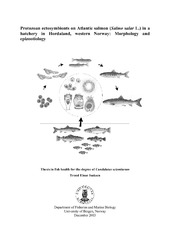| dc.description.abstract | Protozoan ectosymbionts are commonly found on salmonids in Norwegian lakes and rivers. Salmon in hatcheries supplied with water from such watercourses are often infected with such organisms. Despite extensive salmon production, little is known about the infection dynamics of these symbionts on hatchery-reared salmon in Norway. The aim of this work was to study this in a fish farm located in Hordaland, western Norway. Eyed eggs, alevins, fry, parr and pre-smolt were collected approximately bi-weekly in the period January - November, year 2000 (n=2106). In addition, a total of 131 wild fish (salmon, brown trout, rainbow trout, charr and sticklebacks) were caught in the watercourse serving as a water supply to the hatchery, and examined for protozoan ectosymbionts. Five genera of protozoan symbionts were observed on the skin or gills of the farmed salmon. Ichthyobodo sp. (likely Ichthyobodo necator (Henneguy, 1883)) occurred on skin and gills of the farmed salmon. Infections occurred on fry in March (maximum prevalence of infection 38 %), parr in August (23 %) and parr/pre-smolt in September (54 %). Trichodina sp. (likely T. kamchatika Konovalov, Shevlyakov et Krasin, 1970) occurred at low density on the skin of the farmed salmon. It was detected in June (18 %) and again in September-November (4 %). The most commonly observed symbionts were the sessiline peritrich ciliates, Apiosoma piscicola (Blanchard, 1885) and Riboscyphidia sp. (Pickering, Strong et Pollard, 1985), which occurred on the skin (rarely gills), and the suctorian ciliate Capriniana piscium (Bütschli, 1889) that infected the gill lamella (rarely skin). Heavy infections with these ciliates occurred in July, with prevalence of infections equal or close to 100%. Apiosoma infections declined markedly in mid-August, coinciding with an increase in the intensity of Riboscyphidia infection that stayed high during autumn (September-November). Wild salmonids are probably the most important source of ciliate infections to the farmed salmon, while sticklebacks appear to be a reservoir host of Ichthyobodo. No significant mortalities could be ascribed to any of the detected symbionts. Clinical signs like “flashing” and greyish mucus on the body surface were mostly observed among the parr and pre-smolt in the periods when heavy infections of Ichthyobodo and Riboscyphidia occurred. In addition, Ichthyobodo infections were associated with small skin ulcers and areas of scale loss, and correlated negatively with host condition and hematocrit. The sessilines and Capriniana piscium seem to be harmless commensals, and may be useful indicators of aspects pertaining to water quality. | en_US |
